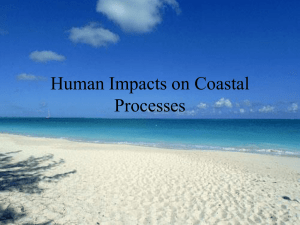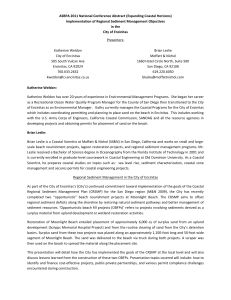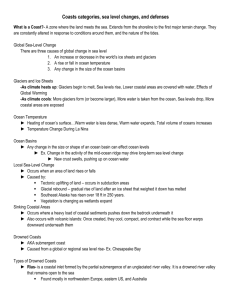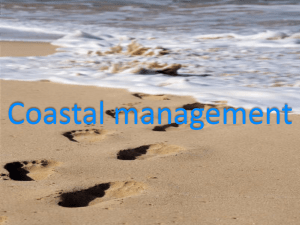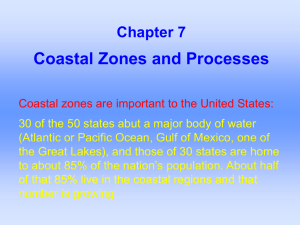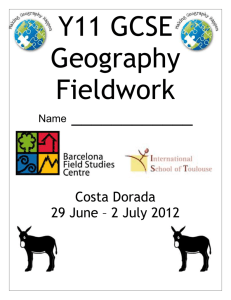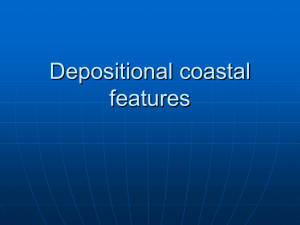Coastal Processes - Science Outreach
advertisement
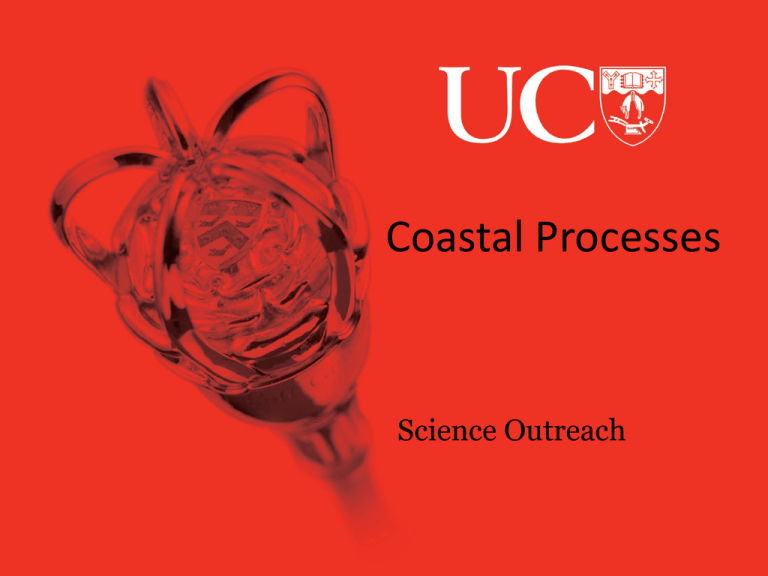
Coastal Processes Science Outreach Interacting Elements of the Coastal System Atmosphere Human Activity & Structures Land Ocean Coast Biology Types of Coastlines in NZ • Rocky shorelines – Form on high energy coasts where the ocean meets mountains or sea cliffs • Sandy beaches – Mainland, pocket and barrier beaches • Coastal wetlands – Swamps, tidal flats, marshes – Rich habitat for wildlife Ocean Currents that influence our coast line: The Marine Environment that we don’t always see: Images: NIWA What is the land doing? • Submerging – Drowned valleys (e.g. Marlborough Sounds) – Deep embayments • Emerging Photograph: C. Kain – Straight shorelines – Marine cliffs (e.g. Kaikoura Peninsula) • Neutral – Deltaic coasts – Alluvial plains (e.g. Canterbury Plains) Agents of coastal change • Base level change Tectonics Sea level change • Sediment supply Lithology (type of sediment) Delivery • Human actions Modify process Modify morphology Modify linkages Coastal processes and timeframes Geological •Inner continental shelf •Transgressive •Lower shoreface •Tidal Basin dune Event •Inlet-rivermouth •Upper shoreface •Frontal dune Instantaneous •Surfzone bars Size of feature Engineering •Beachface •Ripple Time taken for change to occur Adapted from Cowell and Thom, 1994. Beaches • What is a beach? – A beach occurs at the MARGIN of a water body where wave action is the principal agent of change. • Why study beaches? – To understand the processes, identify danger and manage hazards Beaches come in many shapes and sizes Photographs: C. Kain The Dynamic Beach • Each beach is different • Beaches respond to changes in wave energy (try to reach an equilibrium) • Beaches dissipate energy through the movement of sediment (primarily by waves and wind) • Beaches are natural barriers (they protect us!) Profile of a sand beach Source: Hart et al., 2007 During a storm... • Large waves travel a long way up the beach, causing erosion • Sand is removed from the dune and deposited in a bar offshore • The bar helps dissipate wave energy by making waves break further offshore, reducing erosion • Once the storm is over, the sand is slowly brought back to the beach by the waves and deposited on the dunes by wind Human interaction with coasts • We like to live there – coasts are attractive and rich in resources. • Coastal structures that can affect our coasts include: – – – – – – Ports/harbours Sea walls and other protection structures Marine farms Piers Boat ramps Infrastructure (e.g. Stormwater, roads, power poles) Indirect human effects on the coast • If rivers are dammed, then sediment can’t reach the coast. • If too much water is taken out of the river, its capacity to transport sediment is reduced. • If a river can no longer bring sufficient sediment to the coast erosion will occur. • If sand dunes are cut down so people can see the sea - there is no longer any coastal protection in times of storm or tsunami. • Structures change the morphology of the beach and affect sediment moving along it (e.g. New Brighton Pier). Coastal hazards • Occur when people and the coast meet. A natural process is not a hazard until people or infrastructure are threatened! • Coastal erosion and coastal flooding are the main coastal hazards. • Affect people and buildings located within the zone of natural shoreline change. • Coastal flooding will increase due to sea level rise caused by global warming • Others include: wind erosion, storms and tsunami hd • Top: Coastal erosion in the Canterbury Bight (photograph, T. Konlechner) • Right: Boxing Day Tsunami in Banda Aceh, 2004 (photograph, C. Gomez) Options for erosion management • Do nothing – Works well where coasts are relatively free from development • Avoid – Prevent development in the first place • Accommodate – Change land use, building codes, insurance premiums... • Retreat – Move your house/village – most sustainable option long term • Protect – Use engineered options. This is never a permanent fix. (e.g. Amberley Beach) Amberley Beach: Erosion solved?? • Top: Amberley Beach in a state of severe erosion, 2002 • Top right: Renourishment works, 2004. 10 000 m3 of gravel added to beach • Right: After sediment was added, vegetation was planted to help stabilise the new dunes Photographs: DTec Consulting Ltd Photograph: C. Kain Photograph: C. Kain • Top: Sea wall and groyne series, Teignmouth, Devon, England • Top right: Rip-rap revetment, Punakaiki Beach, West Coast • Right: Renourishment works, St. Clair, Dunedin Photograph: DTec Consulting The Development-Disaster Cycle Storm Event Awareness of risk Demand for defence More coastal development Communities/ individuals feel secure Defence works (Modified from Carter et al., 1999) The future of the world’s coasts • Coastlines have been changing shape since the beginning of time – this is not a new phenomenon! • Sea level rise, increased storminess and changing weather patterns (due to climate change) will cause a lot of change in coming years • This leads to an increase in coastal hazards for us as coastal users Conclusion • Coasts are dynamic - they are sensitive to changes • Coastal change can result from changes in natural processes, human actions or a mixture of both • Coastal change is ongoing • We must try to understand this change in order to work with it • For more info on available Geography courses at the University of Canterbury: www.geog.canterbury.ac.nz


